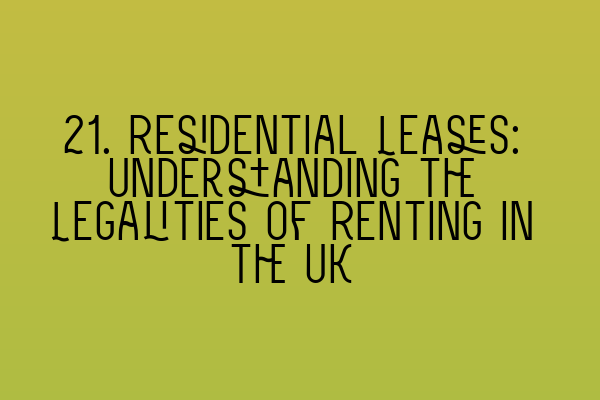Residential Leases: Understanding the Legalities of Renting in the UK
Welcome to the SQE Property Law & Land Law blog! In this post, we will delve into the intricacies of residential leases and the legalities surrounding renting properties in the UK. Whether you are a tenant or a landlord, it is crucial to understand your rights and obligations to ensure a smooth and lawful tenancy. So, let’s jump right in!
1. What is a Residential Lease?
A residential lease, also known as a tenancy agreement or rental contract, is a legally binding document that establishes the rights and responsibilities of both tenants and landlords. It outlines the terms and conditions of the tenancy, including the rent amount, length of the tenancy, and the obligations of each party.
When entering into a residential lease, it is essential to read and understand the agreement thoroughly. Seek legal advice if needed, to ensure you are in compliance with the law and to protect your interests.
2. Types of Residential Leases
There are several types of residential leases in the UK, each with its own legal implications. Let’s look at some common types:
a. Assured Shorthold Tenancy (AST)
An Assured Shorthold Tenancy is the most common type of tenancy in the UK. It offers the tenant a minimum term of six months, during which the landlord cannot evict them without a valid reason. ASTs can be verbal or in writing, but it is always recommended to have a written agreement to avoid any disputes.
b. Non-Assured Shorthold Tenancy
A non-Assured Shorthold Tenancy is a tenancy where the rent exceeds the specified threshold or the tenant’s annual income exceeds a certain amount. In such cases, the tenant may have additional rights and protections under the law.
c. Joint Tenancy
A joint tenancy occurs when more than one person jointly rent a property. Each tenant has equal rights and responsibilities, and they are all jointly liable for the rent and any damages to the property. It is crucial to carefully choose your co-tenants as disputes can arise if one tenant fails to fulfill their obligations.
3. Tenant Rights and Obligations
Tenants have certain rights and obligations to ensure a harmonious tenancy. Let’s explore some key points:
a. Right to Quiet Enjoyment
As a tenant, you have the right to quiet enjoyment of the property. This means the landlord cannot enter the premises without proper notice or without a valid reason. The landlord is responsible for ensuring the property is habitable and in good repair.
b. Payment of Rent
Tenants have a legal obligation to pay rent on time and in full. Failure to do so may result in eviction. It is crucial to keep track of your rent payments and communicate any issues or concerns with your landlord.
c. Maintenance and Repairs
Tenants are responsible for minor maintenance and repairs, such as changing light bulbs or keeping the property clean. However, major repairs and structural issues are the responsibility of the landlord. If you notice any maintenance issues, inform your landlord promptly.
4. Landlord Responsibilities
Landlords also have certain responsibilities towards their tenants. Here are some key points:
a. Providing a Safe and Habitable Property
Landlords must ensure that the property meets health and safety standards and is fit for habitation. This includes providing proper ventilation, heating, water, and maintaining electrical safety.
b. Repairs and Maintenance
Landlords are responsible for major repairs and structural issues in the rental property. They must keep the property in good repair and respond promptly to repair requests from tenants.
c. Protected Deposits
Landlords must protect tenants’ deposits in a government-approved tenancy deposit scheme. This protects the deposit and ensures its fair return at the end of the tenancy, minus any deductions for damages.
5. Legal Remedies and Dispute Resolution
If disputes arise between tenants and landlords, there are several legal remedies and dispute resolution mechanisms available. These include negotiation, mediation, arbitration, or taking legal action through the courts. It is advisable to seek legal advice to understand your options and the best course of action.
We hope this comprehensive guide has provided you with a better understanding of residential leases in the UK. Remember, knowledge is power! If you have any further questions or would like tailored legal advice, don’t hesitate to contact the experienced team at SQE Property Law & Land Law.
Related Articles:
